SQL FULL OUTER JOIN Keyword
SQL FULL OUTER JOIN Keyword
The FULL OUTER JOIN keyword returns all records when there is a match in
left (table1) or right (table2) table records.
Tip: FULL OUTER JOIN and
FULL JOIN are the same.
FULL OUTER JOIN Syntax
SELECT column_name(s)
FROM table1
FULL OUTER JOIN table2
ON table1.column_name = table2.column_name
WHERE condition;
Note: FULL OUTER JOIN can potentially return very large
result-sets!
Demo Database
In this tutorial we will use the well-known Northwind sample database.
Below is a selection from the "Customers" table:
| CustomerID | CustomerName | ContactName | Address | City | PostalCode | Country |
|---|---|---|---|---|---|---|
| 1 |
Alfreds Futterkiste | Maria Anders | Obere Str. 57 | Berlin | 12209 | Germany |
| 2 | Ana Trujillo Emparedados y helados | Ana Trujillo | Avda. de la Constitución 2222 | México D.F. | 05021 | Mexico |
| 3 | Antonio Moreno Taquería | Antonio Moreno | Mataderos 2312 | México D.F. | 05023 | Mexico |
And a selection from the "Orders" table:
| OrderID | CustomerID | EmployeeID | OrderDate | ShipperID |
|---|---|---|---|---|
| 10308 | 2 | 7 | 1996-09-18 | 3 |
| 10309 | 37 | 3 | 1996-09-19 | 1 |
| 10310 | 77 | 8 | 1996-09-20 | 2 |
SQL FULL OUTER JOIN Example
The following SQL statement selects all customers, and all orders:
SELECT Customers.CustomerName, Orders.OrderID
FROM Customers
FULL OUTER JOIN Orders
ON Customers.CustomerID=Orders.CustomerID
ORDER BY Customers.CustomerName;
A selection from the result set may look like this:
| CustomerName | OrderID |
|---|---|
| Null | 10309 |
| Null | 10310 |
| Alfreds Futterkiste | Null |
| Ana Trujillo Emparedados y helados | 10308 |
| Antonio Moreno Taquería | Null |
Note: The FULL OUTER JOIN keyword returns all matching
records from both tables whether the other table matches or not. So, if
there are rows in "Customers" that do not have matches in "Orders", or if there
are rows in "Orders" that do not have matches in "Customers", those rows will be
listed as well.